
Excellence in Research and Development Award Sponsor
Young Professional Award Sponsor
Premium Sponsors
Hosted by
ACKNOWLEDGEMENT
ITS Australia thanks entrants for their particpation in the ITS Australia Awards program and acknowledge their contribution of project descriptions and images for this Awards Book. This book contains a selection of submissions received.
3

4 ITS AUSTRALIA AWARDS 2023 Contents Welcome from the Chair 6 Judge Panel 7 Award Categories 8 Max Lay Lifetime Achievement Award 2023 9 IoT Insights for Real Time Crowd Measurement at Melbourne Central Station Cisco 12 AI for Driving Safer Roads Felicity Smart Infrastructure 13 Mobile Heavy Vehicle Detection and Classification System National Heavy Vehicle Regulator 14 Road Safety at School Zones SAGE Group 15 Project Aardvark – Autonomous Recovery Device for Vehicles Ventia – Brisbane Motorway Services 16 Smart Transport Infrastructure Award Bridj – 2022 Birmingham Commonwealth Games Fleet Management Bridj Technology 18 Omniway Intelematics 19 ODIN PASS: A Mobility as a Service Trial in Queensland Department of Transport and Main Roads Queensland 20 FlexiRide Demand Responsive Transport: Victoria’s New Approach to Mobility Moovit 22 Adapting MaaS Technology to Create PeopleCentric Mobility Solutions SkedGo 24 SkyBus Launched Account-Based Ticketing System and Mobile Ticketing SkyBus 25 Intelligent Mobility Award
5 Connected and Automated Vehicle Award National Regulatory Framework for Automated Vehicles National Transport Commission 26 Enabling Emergency Service V2V Communication for Safety Applications in Australia Q-Free Australia 27 FLEX - Flinders Express Flinders University 28 Connected and Automated Vehicle Data Provision Framework Transport Management Consulting 30 Vehicle-as-a-Sensor – Road Condition Monitoring Program Cisco 31 Service Load Estimation and Real-Time Crowding Prediction for Melbourne Trams Australia Integrated Multimodal Ecosystem (AIMES) 32 Maps Emergency Service Alerts Department of Transport Victoria 34 Service Performance Data Management Solution netBI 35 Network Solutions Analytics Transdev Australasia 36 STREAMS Smart Motorways Dashboard Transmax 37 Customer Journeys Platform Transport for NSW 38 Heads-Up Solution Acusensus Australia 39 Electric Vehicle Infrastructure Charging Network Plan Arup Australia 40 Autonomous Vehicle Technologies for Transport Across Roads, Defence, Mines, Countries and Farms Centre for Robotics, Queensland University of Technology 41 Community Transport of the Future Research Project Institute for Public Policy and Governance, University of Technology Sydney 42 Portable Traffic AI System Sensor Dynamics 43 The Kapsch Intelligent Corridor in AIMES Kapsch TrafficCom Australia 44 SmartGarbos – AI-Powered 5G Garbage Trucks for Roadside Asset Management Swinburne University of Technology 46 ITS Australia iMOVE Research Projects 47 Young Professionals 2023 49 Index 50 Excellence in Research and Development Award Excellence in Transport Data Award
Welcome from the Chair
Each year the Judging Panel selects the finalists from a pool of genuinely outstanding submissions. That, I can assure you is an extremely challenging job. This year, we have 34 finalists in the running for six awards. I congratulate all of you.
Now in their 13th year, the ITS Australia Awards recognise the outstanding work accomplished in the Intelligent Transport Systems industry every year. The Awards bring together the individuals and organisations that make up our industry to celebrate the collective pursuit of safer, innovative, more sustainable and equitable transport solutions in Australia.
Last year’s awards marked the first opportunity that our industry was able to come together in the wake of covid. At this year’s awards, we can celebrate the tremendous resurgence of our industry over the past 12 months. Over this time, we have all attended events together; we have resumed long-delayed business with each other; we have travelled together and reunited with international colleagues. It has been a remarkable period for our industry, and I am so proud to have been able to be part of this joyful time. As we head into 2023, our industry’s forward trajectory looks even brighter.
This is my second year serving as Chair of the ITS Australia Awards Committee, and it has been a great pleasure to continue bringing the Awards together. Once again, I have had the pleasure of seeing the great volume of fantastic work produced again this year. I can think of no better way to kick off the year than by coming together with you, my friends and my colleagues to applaud this outstanding work.
The awards also support emerging talent, and I am pleased to recognise all the finalists for the Young Professional Award. The talent and skills demonstrated by these young professionals indicate a very bright future for our industry.
Finally, I thank our sponsors for their generous support of the ITS Australia Awards and my colleagues on the judging panel who committed their valuable time, effort and expertise this year.

I look forward to seeing all of you at an ITS Australia event this year.
Rob Langridge Chair – ITS Australia Awards Committee Director, Emerging Technologies –Federal Chamber of Automotive Industries

6 ITS AUSTRALIA AWARDS 2023
Judge Panel
Rob Langridge
Chair, ITS Australia Awards Committee
Director, Emerging Technologies –Federal Chamber of Automotive Industries
John Paul Ahern
Executive Director, Intelligent Systems
Transport for NSW
Scott Aitken
Managing Director, AIMSUN
Emilie Alexandre
Senior Project Development Manager, iMOVE Australia
Adele Beachley
Executive Director, SCATS Transport for NSW
Professor Fang Chen
Executive Director Data Science, Distinguished Professor, University of Technology Sydney
Richard Delplace Manager, Regulatory Market Development EROAD
Lachlan Faulkner
Program Manager, Department of Transport and Main Roads Queensland
Nick May
Head of Innovation and ITS Strategy, Transurban
Adriana Simona Mihaita
Senior Lecturer, Faculty of Engineering and Info Tech, University of Technology Sydney
Brian Negus
Ambassador, ITS Australia
Andrew Paynter
Chief Technology Officer, Transmax
Professor Flora Salim
Professor and Cisco Chair of Digital Transport, University of New South Wales (UNSW)
Sydney Deputy Director, UNSW AI Institute
Kim Thomas Managing Director, Integrate
Silje Troseth
Vice President APAC and General Manager, Q-Free Australia
Phillip Walsh
Director Business Development, ANZ Yunex Traffic
Michael Watts
Senior Consultant, Transport Management Consulting
Dean Zabrieszach
President, ITS Australia
Chief Executive Officer, HMI Technologies / Ohmio Automotion
MANAGING CONFLICT OF INTEREST
ITS Australia thanks the Judge Panel for their time and review of submissions. The Judge Panel is comprised of leaders across government, industry and academia. ITS Australia recognise that conflicts of interest may occur, so to protect the integrity and independence of the review process, any judge who has a conflict with a particular entry is excused from reviewing that entire Award category to which the entry/conflict pertains.
7
Award Categories
Smart Transport Infrastructure Award
Recognises an organisation for its technology innovation delivering excellence in transport infrastructure and network management.
Intelligent Mobility Award
Recognises an organisation or project that delivers innovative transport solutions offering outstanding mobility services for people and their communities.
Connected and Automated Vehicle Award
Awarded to an organisation that has made outstanding contributions towards the deployment of connected and automated vehicles in Australia.
Excellence in Transport Data Award
Awarded to an organisation to recognise its outstanding contribution in the use of transport data delivering outstanding outcomes for the community.
Excellence in Research and Development Award
Acknowledges and congratulates research and development activity undertaken solely or in collaborative research programs that recognises an organisation for its groundbreaking transport technology, research, development or innovation. This award is sponsored by iMOVE Australia.
Young Professional Award
This award continues to recognise and encourage the passion and positive contribution an individual has made and is likely to make to the Australian transport technology industry as demonstrated through their early professional life. This award provides sponsorship for the recipient to attend the ITS Australia Summit - Australia’s leading transport and technology event. The option to nominate a young professional is available to ITS Australia members only. This Award is sponsored by Transurban.
Max Lay Lifetime Achievement Award
Recognises an individu al who personifies achievement of the ultimate standard for a leader in the ITS field and in the organisations they have led. The award recognises that they are a champion of the vision of ITS and its fulfilment within the community. The award is named in honour of Dr Maxwell Lay (AM). In 2005, Max was made a Member of the Order of Australia (AM) for service to engineering, particularly through leadership in the delivery of quality road infrastructure and the development of new contract management processes, and as an educator and historian. Max is an Australian pioneer and ITS researcher, engineer, project implementer and passionate advocate for the advancement of ITS.
ITS Australia congratulates Philip Blake as the recipient of the Max Lay Lifetime Achievement Award 2023.
8 ITS AUSTRALIA AWARDS 2023
Max Lay Lifetime Achievement Award 2023
The Motor Vehicles (Trials of Automotive Technologies) Amendment Bill 2016 saw South Australia become the first jurisdiction anywhere to legislate trials for driverless vehicles, with it paving the way for similar pilots around Australia and the world.
Philip Blake has been an important contributor to Australia’s ITS Industry industry for more than 30 years and was a key stakeholder in the introduction and management of the first driverless vehicle demonstration the southern hemisphere.
“I am truly humbled by this recognition by my peers nominating me for the Max Lay Lifetime Achievement Award. I encourage a career in ITS, as it is a chance to work in a very interesting field that offers so much potential for safer, greener and more productive transport,” said Mr Blake.
Philip has led a distinguished career, gaining numerous achievements and awards.
He qualified with a Bachelor of Engineering in Civil Engineering from Swinburne Institute of Technology (Victoria), later adding a Post Graduate Diploma in Management.
Working with numerous teams and partners, Philip contributed to a wide range of projects, initiatives, management groups and committees. In addition, he has shared this knowledge by presenting at various ITS World Congresses, summits, and workshops.
His input to the introduction of new legislation in South Australia to create a framework for on-road autonomous vehicle trials, testing and development, cannot be understated.

Today, every State and Territory in Australia has a driverless vehicle trial, and globally there are more than 100 driverless vehicle trials that have either been concluded or are being conducted. The SA initiative won both the industry’s Government Award and the Automotive Vehicle Award in 2016, with Philip accepting the award on behalf of the Department of Planning, Transport and Infrastructure (DPTI).
In addition to his role with DPTI, Philip was Chair of the South Australian branch of the Transport Australia Society, and was the Engineers Australia Chair, Transport Branch. He is the current Secretary of the South Australia Chapter of the Australasian College of Road Safety and was Director of ITS Australia from 2008 to 2012.
9
Accelerating smarter, safer, sustainable transport


The ITS Australia Global Summit 2023 will bring together Australian and international thought leaders to explore the technologies that will build more intelligent, greener, and safer transport networks to serve the people and cities of tomorrow.
Be part of the discussion. Attend in person at Asia Pacific’s largest face-to-face transport technology event for 2023.

Contact ITS Australia for information on abstract submission, sponsorship and exhibition opportunities. Website: its-australia.com.au | Email: admin@its-australia.com.au Join us in Melbourne, home to the world’s largest urban tram network, Australia’s largest port, and some of the nation’s most significant connectivity, big data, transport and infrastructure projects.
IoT Insights for Real Time Crowd Measurement at Melbourne Central Station
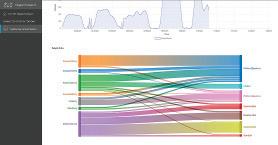
Category
Smart Transport Infrastructure Award
Submitting Organisation

Cisco
Collaborating Partners
Department of Transport Victoria
Metro Trains Melbourne
Cohda Wireless
The University of Melbourne
La Trobe University
In a post pandemic world and with population growth, changing travel patterns and the overcrowding issue at major railway stations will get worse and not disappear. It is very difficult to resolve this issue by just changing station infrastructure. Congestion events due to crowding at stations lead to lost productivity, poor customer sentiment and more importantly create unsafe situations. In this unique trial we have used WiFi signals from devices such as mobile phones, tablets and watches to locate the placement and movement of people at Melbourne Central Station and on trains in realtime. Leveraging AI the solution then uses this data to predict congestion events enabling the possibility of early intervention and mitigation and improving the overall customer experience. The use of WiFi signals to pinpoint the location and movement of electronic devices with nonline-of sight and with a high degree of accuracy is unique. However, when using the same technology to scan passing trains to understand load it begins to offer additional insight into identifying and alleviate congestion at the station.
The benefit of this solution is the capability for situational awareness of a rising congestion event, determine the impact of different control methods based on the data gathered and then raise suitable intervention actions. This will lead to improved asset utilisation, mitigation of safety incidents and an overall better customer experience. Public transport is the most sustainable mode of transport. Detailed knowledge of platform loading and passenger movement at stations are the basis for the efficient and safe management of transport service from planning to operations. This project outcomes has the potential to significantly contribute to the efficient management of public transport stations and improve the customer experience.
12 ITS AUSTRALIA AWARDS 2023 SMART TRANSPORT INFRASTRUCTURE AWARD
AI for Driving Safer Roads

Category
Smart Transport Infrastructure Award
Submitting Organisation
Felicity Smart Infrastructure
Felicity Smart Infrastructure is an Australian company that designs, develops and operate Plug&Play Ai Powered Multimodal Monitoring! Based on a feather light yet ruggedized design, Felicity Smart Infrastructure has successfully launched an Ai powered 24/7 traffic monitoring service designed to provide safer and more efficient traffic networks.

Built for rapid or permanent deployments, this small and only 700 gram GDPR complaint Ai powered visual all-in-one multimodal roadside unit and ripple replay power pack reflects the absolute latest engineering excellence. A GDPR compliant agile service and technology that saves lives and assists sustainable and more efficient transport networks by an Australian company for Councils and Road Authorities across all Countries.
Our deep appreciation and understanding of civil infrastructure has allowed us to design solutions that works within all situations including remote and rural locations where manual intervention is difficult but continued uptime is critical. Felicity’s systems and services are proven and evidenced in Australia but designed for a global market. Our ability to deploy and operate our services within foreign markets evidence the effective and ruggedized designs that wirelessly connect transport authorities and councils to their networks anywhere at anytime. Our systems are powered by either solar or mains power and designed to retrofit onto nearly all existing assets for quick and cost effective deployments with time mission-critical restrictions.
GDPR compliance and de-coded open data protocols leaves our customer with the security and assurance of steady, consistent and reliable transport data that can be utilized unencumbered at all times now and into the future.
13
Mobile Heavy Vehicle Detection and Classification System
Category
Smart Transport Infrastructure Award
Submitting Organisation
National Heavy Vehicle Regulator
Collaborating Partner
SenSen
In late 2021 the National Heavy Vehicle Regulator (NHVR) and SenSen commenced a project to deliver real-time heavy vehicle intelligence to the NHVR.
The resulting world-first Mobile Heavy Vehicle Detection & Classification system (MACP) allows the NHVR to collect real-time intelligence on road network usage by heavy vehicles, and perform subsequent compliance operations if required. With 2 ANPR and 1 sighting camera and associated illuminators, LIDAR and GPS all connected to an NVidia powered Edge Processing system, the Roadside Trailer and Vehicle Lightbar systems use Deep Learning and Live Fusion to combine all these inputs into a single sighting of heavy vehicles.

The Drone Mounted solution uses a high resolution camera and paired laser illuminator to capture vehicles travelling at 100kph from convenient and safe roadside locations. Each sighting contains 15 data points describing the heavy vehicles attributes including axle and articulation counts. Travelling securely over the Telstra IPWAN network, the sightings are received by SenSen’s back-office system, securely hosted in the NHVR’s Microsoft Azure environment, and then handed off in real-time to the NHVR Risk Engines hosted in the same environment.
When a sighting is received, the Risk Engines are able to determine potentially non-compliant heavy vehicles and use geolocation to notify nearby NHVR officers, providing real-time decision support for compliance operations. Sightings that don’t result in compliance activities contribute to an overall picture of the use of the road network by heavy vehicles. Deployed successfully in South Australia, Victoria and Tasmania, the Roadside Trailer, Vehicle Lightbar and Drone Mounted MACP solutions have captured tens of thousands of sightings in the first few months of operation.
The project required significant collaboration between NHVR’s operations teams, data science teams, IT providers and SenSen’s AI and field engineers.
14 ITS AUSTRALIA AWARDS 2023 SMART TRANSPORT INFRASTRUCTURE AWARD
Road Safety at School Zones
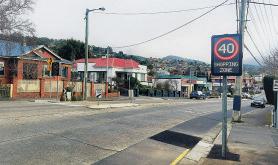
Category
Smart Transport Infrastructure Award
Submitting Organisation
SAGE Group
Rising concerns about road safety near schools have been identified from both parents and school staff. The goal of smart school zone signage is to decrease the average speed of drivers during school hours when there are pedestrians present thus improving the safety of vulnerable road users and increasing the alertness of drivers. Maximising driver alertness and their consciousness of safety via ITS-enabled signage over and above traditional static signage and wig-wags has encouraged more drivers to obey school zone rules.
The new electronic speed limit signs have been fitted with a SAGE Edge device, capturing de-identified data that is providing detailed real-time analysis of the road network traffic performance to the state’s Traffic Management Centre to support flow optimisation and future planning. Additionally, the signage hardware is solar-powered and can operate in adverse weather conditions for increased signage availability, assisting driver awareness of changed speed conditions and improving road safety.
The client can control the operation times of the sign, monitor and update the variable message display and also monitor the system health for any faults remotely. The smart school zone signs have been shown to decrease the average speed of drivers during peak school hours increasing the alertness of drivers, the safety of vulnerable road users whilst minimising driver speed reduction delays. By maximising driver alertness and consciousness of safety through an active and configurable ITS signage messaging, rather than simply another static sign, further encourages drivers to obey school zone rules. Elsewhere, radar-enabled sign variants have also provided measurable statistics on driver behaviour allowing the effects of custom messaging and/or wig-wag functionality activation to be clearly understood.

15
Project Aardvark – Autonomous Recovery Device for Vehicles
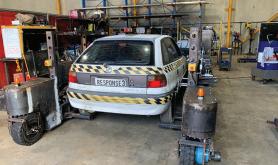
Category
Smart Transport Infrastructure Award
Submitting Organisation
Ventia - Brisbane Motorway Services
Collaborating Partners
Drillman Global Civil to Resources
In collaboration with C2R, Ventia/Brisbane Motorway Services has manufactured an innovative device that will revolutionise the general towing industry and the TIMS industry for high-speed open road networks. Project Aardvark eliminates all manual handling in the vehicle recovery process during tilt tray operations as well as protecting the tilt tray operator being exposed to high-risk work areas, improving situational awareness.
The innovation eliminates the need for the tilt tray operator to place themselves in any position where they are in danger. To do this, a method to isolate the operator from the hazard was designed. The device is capable of retrieving and restraining the vehicle from the roadside and then securely docking back with the tilt tray.
The Aardvark system is powered by a 100 Volt 140Ah battery array that runs the four vertical drive motors and the 20kW motor to run hydraulic pumps. The drive system is capable of carrying a combined load of 5.6tonne at a max speed of 8Km/h and produce over 2000Nm of torque. The 20kw motor runs the hydraulic pump that powers the Aardvark’s 20 hydraulic rams. The lifting rams are designed to lift a 3.2-tonne car 200mm off the ground in 4 seconds. The Aardvark restraint systems relies on three points of contact with the towed vehicle’s wheels. This is achieved with the two lower lifting tines that fold under the vehicle either side of the wheels. The top pressure plate is then inserted between the top of the wheel and wheel arch, then pressure is applied by a hydraulic ram locking the wheel in place. This is done to prevent the vehicle from moving during transport negating damage. The docking system relies on a series of hooks that are lowered from the underside of the Aardvark system, attaching to locking points on the tilt tray.

16 ITS AUSTRALIA AWARDS 2023 SMART TRANSPORT INFRASTRUCTURE AWARD
Australia continues to be a world leader in new technologies and its integration across all road operations. . . with demand for infrastructure and software to support a resurgent transport system, there remains enormous opportunity for new business.


ITS Australia’s Roads, Tolling & Technology conference continues with the new-look NeTC (National electronic Tolling and Charging conference) where delegates will extend their focus from toll roads to include all road operations and associated technology: encompassing motorways, arterials and the networks beyond.
PROGRAM TOPICS
• Project Updates: Smart Infrastructure and Data Deployments
• International Perspectives and Case Studies
• Network Optimisation and Planning
• Future Tolling and Transport Pricing
• Payment Management and Collections
• Commercial Vehicles and Logistics
• Integrated Transport Planning and Delivery
• Traveller and Consumer Experience
• Data Analytics and Tools
• Data for Sustainable and Equitable Transport
• AIMES Projects
• The Future of Roads and Transport
• Smart Tunnels and Bridges
Bridj – 2022 Birmingham Commonwealth Games Fleet Management

Category
Intelligent Mobility Award
Submitting Organisation
Bridj Technology
In January 2022, Bridj were appointed as the Official Fleet Operations and Asset Management Technology Provider for the Birmingham 2022 Commonwealth Game, the 22nd edition of the Commonwealth Games.
The Commonwealth Games consists of 72 Commonwealth nations, over 5,000 Athletes competing in 20 sports, 2,000 VIP’s (Games Family), operating over an 11 day period. It is the second largest multi-sport event in the world, behind the Olympics.
Bridj deployed its booking and fleet management platform at the Birmingham 2022 Commonwealth Games and will go on to support future Games until at least 2030, including our home Games in Victoria in 2026. This long-term partnership enables Bridj to support Commonwealth Games Federation Partnership (CGFP) in the transition of data insights and knowledge from one Games to the next.
Deploying its Operator Portal, to allow the Fleet Team to plan their services, manage a pool of over 1,200 volunteer drivers, a fleet of over 500 vehicles, and monitor daily operations. Providing the Games Family, which comprises over 2,000 members, with a branded Passenger Application to allow them to book a service, track their journey, and access support through their smartphone. Supporting drivers with our Driver App, providing optimised turn-by-turn navigation to passenger pick-ups and drop-offs, which will also adapt to temporary passenger loading zones and road closures during Games time. Drivers can even make a booking on the spot using the Driver App for rank style services required for certain major event load zones.
“As part of the competitive tender exercise, the CGFP identified that Bridj’s offer stood out from its competitors as having the required flexibility and scalability to enhance their user experience and support their goals of reducing the costs associated with staging the Games and making Host Cities/Regions more sustainable.”
Darren Hall, Chief Operating Officer, Commonwealth Games Federation.
18 ITS AUSTRALIA AWARDS 2023 INTELLIGENT MOBILITY AWARD
Omniway Category
Intelligent Mobility Award
Submitting Organisation
Intelematics
Omniway is an all-encompassing mobility-as-aservice (MaaS) platform that enables safer, more convenient, and more sustainable travel. In one user-friendly platform, Omniway offers multimodal planning across public, shared and private transport, including the car, and incorporates a suite of Omni-features for commuters, drivers, cyclists and others.
Omniway takes the complexity out of multimodal travel, making safer and more sustainable travel options easier and more accessible. The unique journey planning algorithm incorporates all modes of transport, including public transport, driving, cycling, walking, e-vehicles and micromobility. It offers multi-modal trip chains that combine a diverse mix of travel types to meet the demands of the new and future traveler. Data is used to determine the safest and most efficient route as well as activities such as parking at the destination.
The cycling feature incorporates cycling infrastructure data provided by various sources to promote safer, accessible cycling options to aspiring riders. By providing safer cycling routes, Omniway breaks the barrier for new cyclists to encourage more people to travel by bike.
Omniway considers the importance of the private vehicle and includes features to improve the efficiency of users that choose to drive. The app includes fuel station locations, parking, pricing, integrated account management and payment capability.

Clients range from auto clubs and OEMs to government and institutions. The MaaS product can be delivered as a white-label solution, purpose built to the requirements outlined by government or a corporation, or as a custom-built solution. For clients with an existing application, features of Omniway can be integrated to negate the need for a new app.
The technology is complemented by Intelematics’ 20+ years of experience in using complex traffic data to provide live navigation and comprehensive insights into how people move about for government and automotive clients.
19
ODIN PASS: A Mobility as a Service Trial in Queensland
Category
Intelligent Mobility Award
Submitting Organisation
Department of Transport and Main Roads
Queensland
Collaborating Partners
University of Queensland
iMOVE Australia
SkedGo
ODIN PASS
ODIN PASS, Australia’s largest Mobility as a Service (MaaS) research trial is embodying a shift away from the privately owned car towards sustainable mobility solutions that are consumed as a service.
ODIN PASS combines public and private transportation services, accessed via one application which provides personalised journey planning, booking and payment.

The ODIN PASS trial is key in providing sound evidence about a sustainable underlying business model for MaaS that would see government and private industry create multimodal and multi-service MaaS products for Queenslanders, enabling better travel options.
Since launch in July 2021 to the end of August 2022, ODIN PASS has had over 4,250 users participate in the trial with more than 9,000 mobility bundles sold, and over 50% of participants purchasing two or more bundles.
ODIN PASS data insights combined with early economic modelling predicts Queenslanders could see a range of benefits including:
• Enhanced Customer Responsive Service –predicted journey time saving of 4.5 minutes per trip, reduced private vehicle operating and ownership costs as less vehicles will be needed.
• Enhanced Liveability and Land Use – reduced negative externalities associated with lower private vehicle use (greenhouse gas emissions, noise, pollution), by a forecasted 8 million less trips by 2040.
• Improved Value for Money Outcomes – reduced costs to serve and increased public transport revenue, an estimated $102.9 million benefit.
• Improved Road and Transport Safety Outcomes – reduced private vehicle and lower associated road crashes.
• Enhanced Network Stewardship – increased public transport patronage, up to 5 million extra trips by 2024, due to mode shift driven by MaaS integration.
The learnings from ODIN PASS are being adapted to inform other trials and research conducted by the department’s MaaS program which are in early, planning phases.
20 ITS AUSTRALIA AWARDS 2023 INTELLIGENT MOBILITY AWARD
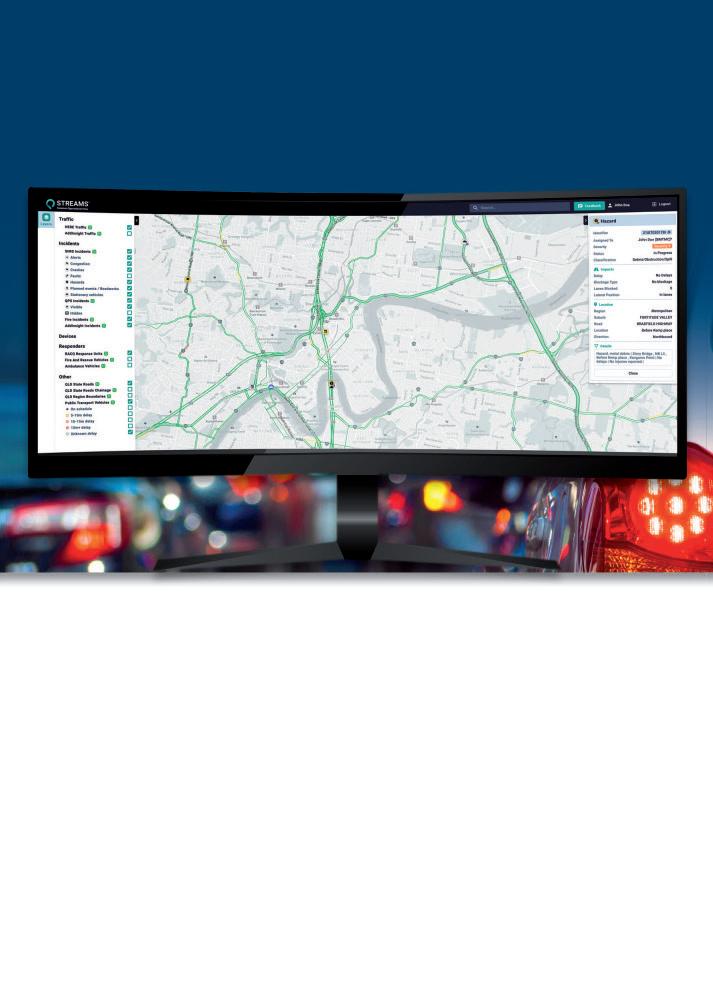
FlexiRide Demand Responsive Transport: Victoria’s New Approach to Mobility
Category
Intelligent Mobility Award
Submitting Organisation
Moovit
Collaborating Partners
Ventura Bus Lines
Department of Transport Victoria
In December 2020, Ventura Bus Lines and the Department of Transport Victoria launched FlexiRide Rowville, Melbourne’s first on demand transport service. Within 14 months, the service was recognised by the UITP and awarded their highest honour in the design category.
FlexiRide, powered by Moovit Transit On Demand, has no fixed route or timetable. Instead, it dynamically responds to trip requests, offering better public transport connections with decreased wait times. Using a demandresponsive transport service that can be ordered through a smartphone app has encouraged more people to use public and shared transport and decrease their reliance on private cars, ultimately reducing carbon emissions. The service is not only sustainable, but is also adaptable to fastchanging needs and durable: operators can quickly adjust the number of deployed vehicles, the number of patrons allowed on board, and provide door-to-door service for patrons that require it.
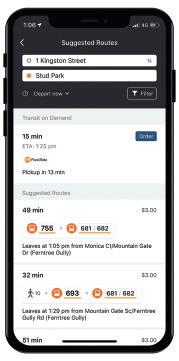
The service addresses the inconvenience of the previous Dial-a-Ride approach which was in operation for over 30 years. Within a few months patronage grew five fold, wait times dropped by 80% and travel times were more than halved.
Since the launch of FlexiRide Rowville, four additional FlexiRide DRT services have been launched, each with their own unique characteristics and challenges. Over nine telebus services and three bus routes have been successfully converted to full on demand services. FlexiRide is here to stay in Victoria and beyond.
22 ITS AUSTRALIA AWARDS 2023 INTELLIGENT MOBILITY AWARD
Future Mobility has become one of the fastest growing sectors in the ITS industry and is a key contributor to smart transport and the liveability of our cities, suburbs and regional communities. It coincides with other customer centric, demand responsive transport initiatives to mark a global trend towards sustainable and accessible urban mobility.
TOPICS: PROGRAM TOPICS
• Government Updates and Key Focus Areas
• Project Updates from Australia and Overseas
• Smart Infrastructure

• Data Ecosystems
• Mobility on Demand
• Mobility as a Service


• Active Transport
• Micro Mobility
• Rural and Regional
• Accessible and Equitable Mobility
• Sustainable Transport
Adapting MaaS Technology to Create People-Centric Mobility Solutions

Category
Intelligent Mobility Award
Submitting Organisation
SkedGo
Recognising that one size does not fit all, SkedGo has adapted its proven MaaS technology to a diverse range of communities. This approach allows governments, transport authorities, businesses and nonprofits to launch highly tailored, localised solutions serving demographics such as commuters, employees, students, and underserved communities.
Using its unique API, SDK and white label technology, organisations can rapidly create their own multi/mixed modal MaaS offering, including journey planning, parking, book & pay, events and itineraries. SkedGo’s solutions provide personalised and contextual trips to the end user based on speed, cost, convenience, low carbon emissions and active travel.
Wheelchair routing, out-of-order lifts, cycle/path ‘friendliness’, and customisable walking speeds support safer travel for everyone, particularly people who are neurodiverse, have reduced mobility, the elderly and parents with children. Its crowding levels feature allows passengers to choose quieter routes/carriages or switch to alternative modes, providing real-time information on passenger numbers, arrival times and service information.
The emphasis on people-centric MaaS solutions has led to the global adoption of SkedGo’s technology. It is already being implemented in Europe, UK, USA and Japan as well as Australia. Examples include Leicester City Council and Transport for Greater Manchester (UK), to encourage active travel and increase public transport usage; and Feonix - Mobility Rising (USA), a nonprofit, to support underserved communities including low-income families.
Skedgo is also the technology enabling partner providing the platform for the ODIN PASS app The subscription-based app offers students and staff access to a range of transport options. The success of this project has seen it expand to allow for a further 5,000 subscriptions. The trial has recently been extended to ITS Summit 2022 delegates, providing a new way for visitors to travel around Brisbane and South East Queensland during the event.
24 ITS AUSTRALIA AWARDS 2023 INTELLIGENT MOBILITY AWARD
SkyBus Launched Account-Based Ticketing System and Mobile Ticketing

Category
Intelligent Mobility Award
Submitting Organisation
SkyBus
Collaborating Partners
Fujitsu Australia
Masabi
SkyBus, Fujitsu and Masabi worked to develop a next-generation Account-Based Ticketing solution, powered by Masabi’s Justride platform. The solution gives SkyBus passengers the ability to purchase tickets anywhere, anytime and enables fully contactless ticketing, with new Justride Validation units installed across the fleet. The solution is deployed in Melbourne, Brisbane, and Hobart, and supports online ticket purchases, onboard and self-service kiosks, with over a million people having used the service since launch.
The Covid-19 pandemic highlighted the need for seamless, low-touch and Covid-safe contactless payment solutions to drive passenger uptake, ensure safety, and help ridership recover as the situation normalised – while providing an easily implementable solution that could withstand similar events. Masabi and Fujitsu’s approach meant that SkyBus could quickly implement a complete Account-Based Ticketing system, removing the need for passengers to interact with staff and physical ticketing infrastructure, while massively increasing convenience– with passengers able to use their phones to buy tickets and passes anytime, anywhere with an upgrade path to open payments, making using SkyBus services easier than ever before.
The cloud-native solution is integrated and managed by Fujitsu using Masabi’s world-leading Justride suite of APIs, and its mobile ticketing SDK. Thanks to Masabi’s Fare Payments as a Service model, SkyBus will benefit from regular updates and a future-proof roadmap, keeping up with the pace of technology change. By making public transport easier and more convenient to access, SkyBus, Fujitsu and Masabi are enabling people to move away from the use of private cars, helping to reduce congestion and pollution in city centres and around airports, and helping achieve social and environmental goals. Masabi’s Justride has helped transport authorities across the world increase accessibility and efficiency and drive passenger uptake, moving more people away from private vehicles and onto public transport.
25
National Regulatory Framework for Automated Vehicles
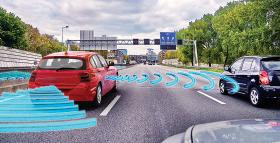
Category
Connected and Automated Vehicle Award
Submitting Organisation
National Transport Commission
Collaborating Partners
Department of Infrastructure, Transport Regional Development, Communications and the Arts, Government of Australia
Transport for NSW
Department of Transport and Main Roads
Queensland
Department for Infrastructure and Transport
South Australia
Department of State Growth Tasmania
Department of Transport Victoria
Department of Transport Western Australia
Transport Canberra
Department of Infrastructure, Planning and Logistics
Northern Territory
Automated vehicles – sometimes known as autonomous vehicles or “driverless cars” –offer the possibility of fundamentally changing transport and society by improving road safety, mobility, freight productivity and by reducing road congestion. An NTC commissioned study found up to $64 million dollars in annual benefits once AV technology is widely adopted. However, current laws do not support their use on public roads. We need nationally consistent reforms that support innovation and safety. This will allow Australians to access the benefits of this technology.
The NTC has collaborated across government, industry and community to design an endto-end regulatory framework to support the safe commercial deployment and operation of automated vehicles at all levels of automation in Australia. This is underpinned by four important principles:
• Outcome based reform with safety as a key priority
• Technology, applications and business model neutrality
• National consistency and international alignment
• Commencement of framework in 2026
In February 2022, Australian transport ministers agreed on the foundational elements of that regulatory framework – first supply rules using exiting Commonwealth vehicle standards legislation along with a new Australian Design Rule; a new Commonwealth in-service safety law including a general safety duty and a new Commonwealth regulator; and complementary state and territory laws to support licensing, registration, and on road enforcement.
Now the NTC, along with our partners in the state, territory, and Commonwealth governments, move into implementation – reviewing and drafting new and amending legislation, developing operational policy and procedures, and ensuring the readiness of other supporting aspects of Australia’s transport system.
26 ITS AUSTRALIA AWARDS 2023 CONNECTED AND AUTOMATED VEHICLE AWARD
Enabling Emergency Service V2V Communication for Safety Applications in Australia
Category
Connected and Automated Vehicle Award
Submitting Organisation
Q-Free Australia
Collaborating Partners
Lexus Australia
Ambulance Victoria
Australia Integrated Multimodal Ecosystem (AIMES)
Cooperative Intelligent Transport Systems (C-ITS) enables emergency service vehicles to share awareness messages with surrounding vehicles, request priority at signalised intersections, and consume event notification and information messages. Development of this technology by Q-Free and real-world testing with collaborators including Lexus, Ambulance Victoria, and AIMES increases the broader Intelligent Transport Systems conversation in Australia and builds C-ITS expertise across industries.
The Emergency Service Vehicle Notification C-ITS use case aims to minimise emergency vehicle response time and improve road safety by:
• improving situational awareness for road users of any emergency vehicle in the vicinity;

• providing directional-based alerts to contextualise the situational awareness; and
• warning of stationary or slow-moving emergency service vehicles and providing recommended actions such as a reduced target speed, in accordance with local regulations.
Based on C-ITS standards and Emergency Service Vehicle Notification specifications, Q-Free Australia developed the software and provided vehicle-mounted hardware devices to perform real-world testing, with integration to ambulances including light bars and sirens, and to standard road vehicles including human-machine interface (HMI) with display and audio. The software was developed using sophisticated Geographic Information System (GIS) simulations prior to real-world testing using Q-Free provided C-ITS hardware.
Testing with vehicles in a controlled environment provided the necessary feedback to improve the system prior to real-world testing in the AIMES precinct. The successful demonstration of the use case showed a significant increase in situational awareness amongst the vehicle drivers. The visual and audio warnings provided timely contextual information to the driver. The driver had accurate information about the approaching ambulance based on the presented alert and responded appropriately. Overall, this use case demonstrated effective communication between vehicles, which resulted in a safer and more efficient working environment for emergency services.
27
FLEX – Flinders Express
Category
Connected and Automated Vehicle Award
Submitting Organisation
Flinders University
Collaborating Partners
Department for Infrastructure and Transport
South Australia
iMOVE Australia
Royal Automobile Association of South Australia
Keolis Downer
SAGE Group
Navya
The Flinders Express (FLEX) shuttle was South Australia’s first autonomous vehicle (AV) trial using public roads to offer a first and last mile shuttle service to the Flinders train station within the Tonsley Innovation District. Flinders University, together with a number industry project partners and supporters have collaborated to deliver this project.
Phase 2 of the project continued to build on the lessons learnt from the initial project and developed new and innovative use cases for FLEX. These new use cases tested new operational modes for autonomous vehicles, use vehicle to infrastructure (V2I) communications technologies to improve performance and finally testing a living lab that will in the future serve as a test bed for connected and autonomous vehicles.
Project partners for the Phase 2 trial include: South Australia’s Department for Infrastructure and Transport, Flinders University, Royal Automobile Association of South Australia, iMOVE with project support from Keolis Downer and tech support from SAGE Group and Navya.
The pilot is also investigating the integration of autonomous bus technology with SA’s transport network and the public response to driverless technologies.

Flinders University Head of Civil Engineering, Professor Rocco Zito, says “stage two of the FLEX trial has developed further understanding on the system requirements for automated vehicles by establishing Tonsley as an AV test bed for future trials and operations. “
“It’s important to learn how the use of automated vehicle technology can be adapted into our future planning with the integration of other technologies, so stage two of the FLEX trial can provide greater insights into developing the physical infrastructure and technology required to provide better services for the public and we’re encouraging everyone to try it out.”
28 ITS AUSTRALIA AWARDS 2023 CONNECTED AND AUTOMATED VEHICLE AWARD
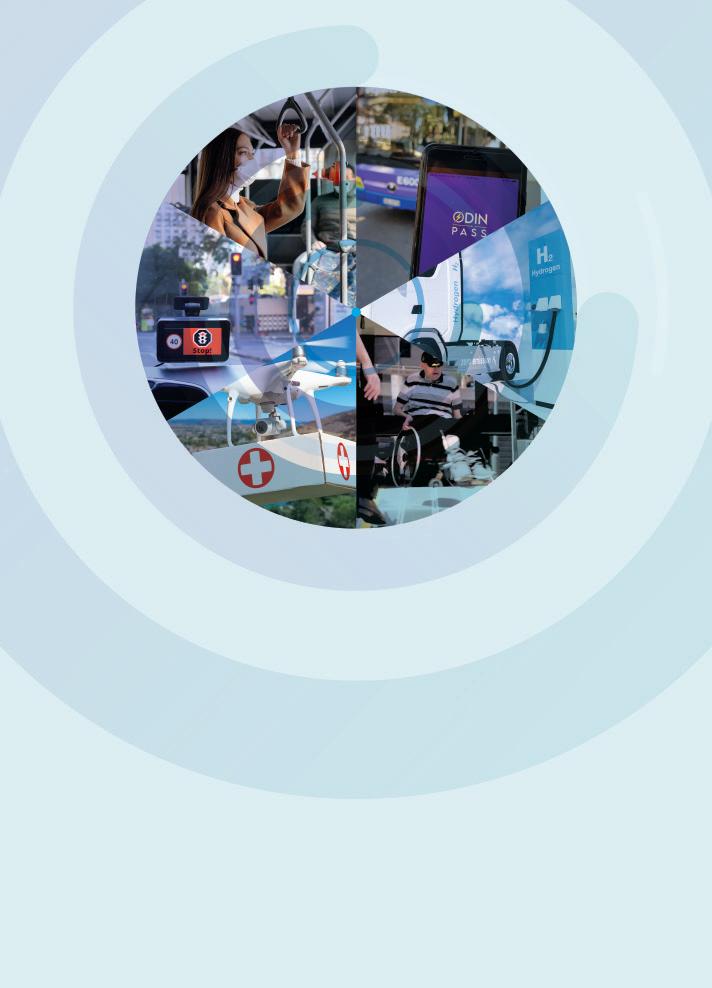
Connected and Automated Vehicle Data Provision
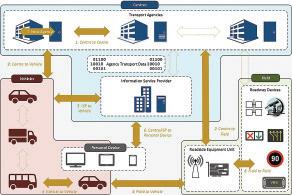
Framework Category
Connected and Automated Vehicle Award
Submitting Organisation
Transport Management Consulting
Collaborating Partner
Austroads
CAVs rely on a variety of data sources to build situational awareness, assist navigation and support decision making. This includes static and dynamic data from road agencies, commercial information service providers, and crowd-sourced applications.
Australian road agencies currently maintain unique practices of data definition, collection, use and storage. This inconsistency presents challenges for road agencies and map makers that collect data and supply it to CAVs. Adoption of consistent road agency CAV data provision practices across road agencies in Australia can address these challenges.
Thus, this project developed a CAV Data Provision Framework that can be used by agencies to build their business and technology capability in providing data to CAVs. The Framework consists of a Capability Model that enables agencies to establish their target CAV capability and plan towards their desired future state; a reference ITS architecture to provide business and technology blueprints for the provision of static and dynamic agency data (e.g. roadwork, incidents, traffic signal phase and timing, static and variable speed limits, lane control signals, heavy vehicle access restrictions); and implementation guidance.
The Framework is flexible and adaptable, with a five-level Capability Model that caters for the spectrum of CAV types and enables agencies to select tangible targets to suit their respective needs and targets. The levels provide CAV data provision guidance for current-day human controlled vehicles (a new Day 0.5 concept), through to fully cooperative (C-ITS) and automated vehicles (Day 4).
The Framework provides a nationally consistent approach to preparing, managing and providing data to CAVs. This will lead to synergies and efficiencies across government and industry, assisting Australian road agencies in developing their CAV data provision capabilities.
The CAV Data Provision Framework is now being used by Austroads to develop further agency CAV guidance and as a reference by agencies to guide CAV projects.
30 ITS AUSTRALIA AWARDS 2023 CONNECTED AND AUTOMATED VEHICLE AWARD
Vehicle-as-a-Sensor – Road Condition Monitoring Program

Category
Excellence in Transport Data Award
Submitting Organisation
Cisco
Collaborating Partners
Transport for NSW
Australian Road Research Board
University of NSW
Poor road surface conditions and potholes have a detrimental impact for customer journeys – not only do they cause costly vehicle damage but they also are a safety concern as drivers swerve to avoid hitting them. They also increase fuel consumption and leaving them unattended can degrade the underlying road surface quality. Fixing potholes is the largest cost in road maintenance.
Cisco, Transport for NSW, Australian Road Research Board and University of NSW have created a solution which uses the bus network to digitise the road surface and identify potholes. As part of a trial, a number of buses were outfitted with a Cisco IoT Edge Router with an in-built GPS and accelerometer sensor to initially look at location services. However, following the recent floods in NSW the rich data from the buses were used to scan the road surface and turn the movement of the vehicle into an index - digitising the road surface. Australian Road Research Board and University of NSW both played an important role in correlating the bus data to the RRI historical data. Typically, the road surface is surveyed every 1 to 4 years. Now, using the bus network it is being scanned every 30 mins.
As population growth increases and travel patterns change in a post pandemic world the roads are becoming increasingly important in the safe delivery of people and goods. The quality of those assets and ability to support rising number of vehicles will continue to be important and hence he ability to digitise the road and understand in real-time the performance of the asset and identify incidents is vital. This solution is a unique way in which to digitise the road and provide those insights into asset performance and create safer and more enjoyable journeys for the whole community.

EXCELLENCE IN TRANSPORT DATA AWARD 31
Service Load Estimation and Real-Time Crowding Prediction for Melbourne Trams

Category
Excellence in Transport Data Award
Submitting Organisation
Australia Integrated Multimodal Ecosystem (AIMES)
Collaborating Partners
The University of Melbourne
Department of Transport Victoria
Yarra Trams
Cubic Transportation Systems
iMOVE Australia
Detailed knowledge of service utilisation and passenger load profiles for public transport service is the basis for the design and optimisation of public transport service plans and operations.
The research team has developed an integrated suite of data fusion software and machine learning models to digest very big datasets that are usually underutilised (including farecard data, tram location data, pedestrian sensor data, traffic sensor data, population, land use, census data, etc.) and make the most accurate estimates of service utilisation for Melbourne trams, especially inside the free tram zone which is currently unobserved, and to make real-time prediction of tram loads for operational applications. This data allows operators to monitor day-to-day variability of travel demand and understand demand responses to service disruptions, special events, and restrictions (e.g. COVID-19).
The outcomes of this project allow operators to reduce the number of required devices and monitor service utilization cost-efficiently, especially in public transport networks where farecard data coverage is usually incomplete and negatively skewed. This will not only help operators to accommodate the variability in passenger demand and provide more efficient service, but also assist passengers in journey planning to avoid service overcrowding.
In terms of sustainability impacts, the developed models and software packages outcomes have the potential to facilitate:
• Optimisation of service plans, frequency, efficiency and utilisation- minimisation of operational cost and fuel/energy consumption.
• Reduce the number of required data collection devices (on-board sensors).
The advanced models and methodologies produced in this project are directly applicable to service load estimation for trains, and buses, and crowding prediction at train stations and platforms which have significant safety implications. The proposed method are also transferable to big data approaches from other modes of transport that are widely and automatically monitored.
32 ITS AUSTRALIA AWARDS 2023 EXCELLENCE IN TRANSPORT DATA AWARD

Maps Emergency Service Alerts
Category
Excellence in Transport Data Award
Submitting Organisation
Department of Transport Victoria
Collaborating Partner
Google Maps
During September 2021, large scale anti-vax protests were held in Melbourne, with Victoria Police enforcing an unprecedented exclusion zone around the CBD. In response, the department halted public transport services into and out of the area and police established road blocks at all entry points. The department sought to respond and provide customers with information consistent with Victoria Police orders and transport communications at the time across its channels.

The department’s open data approach was critical to the government response to this issue. The department worked to provide Google Maps with a geospatial map of the exclusion zone and identification of all train, tram and bus stops and services within the area – and for the first time, remove all timetabled services from customer view. Google worked with the department and also provided customers with “Police Activity” service alert information and transport communication broadcast messages relating to the protests, as well as directing them to the Public Transport Victoria website for more information. Following the end of the exclusion zone, transport information seamlessly returned to Google.
The provision of this information by the Department of Transport Victoria and Google received considerable positive feedback from City of Melbourne, Victoria Police and operators. Similar geo spatial mapping of emergency areas has been provided by Google Maps in other jurisdictions, including in Auckland during COVID where drivers using Google journey planning were provided with automated voice alerts as they entered COVID restricted areas; and in South Australia as drivers enter Fruit Fly Zones. Early discussions were also had with Google and Transport for NSW during COVID to activate automated voice alerts within the Google Maps product, as drivers crossed the border, however this option was not progressed due to removal of border entry requirements at the time.
34 ITS AUSTRALIA AWARDS 2023 EXCELLENCE IN TRANSPORT DATA AWARD
Service Performance Data Management Solution
Category
Excellence in Transport Data Award
Submitting Organisation
netBI
Collaborating Partner
Public Transport Authority of Western Australia
WA’s Public Transport Authority (PTA) undertook a three-year project with netBI to develop an automated data-capturing and reporting system to measure 100% of its public transport operator’s performance.

AI and ML are utilised to resolve data issues and uncover rich insights from 480 million data points per month, to automate calculation and reporting of missed stops, missed trips and on-time running performance for every trip (~440,000 scheduled trips, ~15 million stops monthly).
The system replaces manual reviews of only 1.0% of monthly timetabled trips from one data source. The AI automatically excludes planned network disruptions (e.g., roadworks), capturing causes for unmet targets enabling accurate payments/penalties calculations. This creates a future-proofed single source of truth through: fault tolerance (more data sources/redundancy), faster workflows, defensible metrics and payments, and reporting tools to oversee billions in public spend. Operators can explain unmet targets for review and adjustment based on a transparent audit trail — with full spatial integration.
Attribution helps PTA address short-term impacts, like driver shortages, and plan long-term improvements. PTA and operators can negotiate better KPIs and incentives using trusted insights, enabling improvements in passenger experience. This all leads to better timetabling, recovery times, enabling electrification of vehicles and reduction of fossil fuels.
netBI’s solution supports effective partnerships between regulators and providers by offering a single source of truth of network performance. One advanced AI application helped improve timetabling: Some operators have reported a 50% decline in customer complaints over 12 months due to improvements.
Changing travel patterns and growth in technologies means leveraging data is key to adaptability. Insights inform strategic procurement to meet policy objectives, deliver viable contracts for operators, enhance service quality for consumers, and transparently inform spending. PTA can demonstrate best governance in managing high-value contracts and improve network designs and timetables, as operators enhance passenger experience.
35
Network Solutions Analytics
Category
Excellence in Transport Data Award
Submitting Organisation
Transdev Australasia

Collaborating Partner
Lynxx
Changing customer expectations require greater agility from Public Transport Operators. Leveraging cloud computing and machine learning, Transdev’s Network Solutions Analytics provides visibility on the entire customer journey by marrying operational and weather data, ticketing information and more data points to monitor past performance as well as model future demand and schedule adherence. It enables a change in paradigm: a shift from merely being the best at moving vehicles, toward optimal outcomes for customers and communities.
Built as a single platform, Network Solutions Analytics allows cross-referencing between datasets to support causality analysis. Insights are organized into 10 distinct modules across three pillars, each with built-in quality control mechanisms: Customers & Performance; Scheduling & Reporting; and Operational Excellence. This knowledge is made available at all points of the decision chain through dashboards tailored for specific audiences.
Network Solutions Analytics provides sustainable benefits by optimising resource deployment. For example, the tool was recently used to inform a recut in one of our NSW bus contracts, leading to the delivery of 1.4% more services and a reduction of dead-running by 0.7% using the same resources. By supporting better quality services, it also contributes to improved public transport competitiveness against less sustainable transport alternatives (air and sound pollution, road network effectiveness) benefiting the whole ecosystem.
Developed under the auspices of future-proofed data models, the solution will continue to develop, seamlessly integrating AI and machinelearning extensions. Initially conceptualized in collaboration with Lynxx for NSW bus operations, the tool is already being successfully deployed in other jurisdictions (WA, QLD) and is being showcased internationally to both Operators and Authorities.
36 ITS AUSTRALIA AWARDS 2023 EXCELLENCE IN TRANSPORT DATA AWARD
STREAMS Smart Motorways Dashboard
Category
Excellence in Transport Data Award
Submitting Organisation
Transmax
The STREAMS Smart Motorways Dashboard provides a suite of visuals and reports designed to monitor, assess, and optimise motorway performance using live data. Within the first 10 months of deployment along 13km of Perth’s Kwinana Freeway, travel time was reduced on average by 20%.
Transmax’s existing ramp metering technology has been deployed for some time. The STREAMS Smart Motorways Dashboard developed in the past two years leverages this technology and has been operational in Queensland and Western Australia since 2019 and 2020 respectively. The application generates insights from live traffic data to manage motorway congestion as traffic demand and patterns continue to change over time. Reporting capabilities allow users to proactively identify where critical bottlenecks are developing to focus their attention.
Road agencies deploying STREAMS Smart Motorways and communities already benefit from reduced travel times and other social, economic and environmental benefits. The STREAMS Smart Motorways Dashboard will contribute to safer and more efficient motorway journeys.
The solution is currently operational in Denver, Colorado, and undergoing design for use in California. The application also integrates with other STREAMS ITS applications, such as Transmax’s situational awareness dashboard. The solution is adaptable for use with emerging vehicle detection technologies and ramp signal controllers, transforming this data into digestible insights for users.
The application rapidly informs users about network performance, allowing operators to respond in real-time. Removing the need for reactive traffic analysis and reducing dependencies on subject matter experts, the easy-to-use solution caters to a range of users.
Designed to optimise existing motorway capacity, this cost-effective solution offers an alternative to building additional lanes (and the associated significant environmental, societal and budget costs). By more efficiently routing vehicles, reducing stop-start congestion and the need for additional infrastructure, the STREAMS Smart Motorways Dashboard is designed to provide sustainable benefits to society.

37
Customer Journeys Platform
Category
Excellence in Transport Data Award
Submitting Organisation
Transport for NSW

Collaborating Partner
PwC Australia
Transport is placing the customer at the Centre. Our aspiration of creating seamless connected journeys is dependent on understanding the travel patterns and demands of our customers. Transport for NSW and PwC have jointly developed a near-real-time insights and simulation platform, providing a customer-centric view of Transport for NSW’s multimodal public transport network. This will enable Transport for NSW to make operational and planning decisions using whole of network and multimodal insights at a network, mode and precinct level.
An Australian first, the Customer Journeys Program brings together multi-modal insights to inform decisions to achieve this vision. Improving the connectivity of our public transport network and services will lead to an increase in accessibility, improved capacity management and other safety aspects and unlock further opportunities in mobility as a service where it has already been used to guide focus areas for trials. These are measurable benefits that can be tracked within the program.
The innovation of the Customer Journeys Program is its ability to measure network performance from the customer’s viewpoint allowing users to instantly drill-down to individual services across multiple metrics, which are designed to better describe actual customer experience, and calculated by bespoke software solutions. The metrics are processed in near-real-time using an AWS based technology stack.
The Customer Journeys Program is a cloud-based platform, using automated data processing and cutting-edge analytics to deliver a robust and future-proof solution for Transport for NSW. Fully integrated into their existing systems and accessible through a web front end as well as API connectors, it’s been developed to easily allow new data sources, new transport modes, network modifications, and other changes to be automatically incorporated. This has enabled a greater level of on demand data democratisation across Transport for NSW than ever before. We are opening up possibilities for new audiences to leverage insights and have triggered a shift towards a customer-centric data driven decision making culture.
38 ITS AUSTRALIA AWARDS 2023 EXCELLENCE IN TRANSPORT DATA AWARD
Heads-Up Solution
Category
Excellence in Research and Development Award
Submitting Organisation
Acusensus Australia
The Acusensus ‘Heads-Up’ has been designed to give authorities an effective tool to address distraction and other illegal driver behaviour, to drive behavioural change on the road network.

The Acusensus ‘Heads-Up’ solution is a system in which AI technology is utilised to detect potentially harmful driving behaviour, including spotting distracted drivers, drivers without seatbelts, as well as speed violations.
The system can be provided in the form of fixed or trailer-based enforcement for anytime, anywhere deployment.
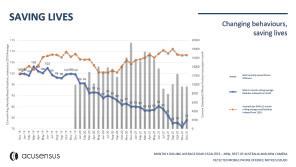
The system captures high resolution, prosecutable evidence of individuals undertaking illegal driver behaviour, 24/7 in all weather conditions and, operates autonomously to capture photographic evidence, automatically detecting illegal driver behaviour. The system hardware is compact, light and unobtrusive, permitting economical deployment on a wide range of pre-existing infrastructure.
Acusensus partnered with Transport for NSW to deliver the world’s first automated illegal mobile phone use enforcement system. Going live on 1 December 2019, the program commenced with a warning letter phase before moving to live enforcement on 1 March 2020. In the first 3 months of operations, the program checked 10 million vehicles and detected over 30,000 drivers using their phones whilst driving. The program encompasses both fixed and transportable systems, covering the entire state.
Acusensus has also partnered with the Queensland Government in its efforts to address dangerous driver behaviour across their road network in Australia’s first simultaneous enforcement of illegal mobile phone use and seatbelt non-compliance detection program, going live at the end of July 2021. Nearly 6,000 Queenslanders were detected illegally using their phones behind the wheel and nearly 1,000 offences detected involved front-seat occupants not wearing a seat belt in just three weeks.
EXCELLENCE IN RESEARCH AND DEVELOPMENT AWARD 39
Electric Vehicle Infrastructure Charging Network Plan

Category
Excellence in Research and Development Award
Submitting Organisation
Arup Australia
Collaborating Partner
Perth South West Metropolitan Alliance
The Perth South West Metropolitan Alliance EV Infrastructure Charging Network Plan communicates the appropriate EV charging types, requirements, infrastructure, potential electricity network impacts and policies to support EV uptake. The plan showed recommendations spatially, creating a blueprint for the Perth South West Metropolitan Alliance to help guide EV uptake.
The team prepared a comprehensive outlook of the EV ecosystem at the snapshot in time. This covered an overview of best practice policy, stakeholder perspectives and an assessment of future demand. A key part of the review was spatial analysis of socio-economic affluence and grid performance. The team used the ABS SEIFA dataset and Energy Networks Australia Network Opportunity Maps to identify constraint and opportunity areas.
The rollout of EV infrastructure has the danger of being co-located in areas of high affluence, where monetary benefits of charging are considered more important than social or environmental benefits. A key aspect of this work was to maximise benefits across the participating LGAs to deliver a network with equitable access that supports widespread adoption of EVs. As mentioned earlier, research identified areas of low socio-economic affluence and poor grid performance, recommending a balance spread of future infrastructure and policies to benefit the community equitably.
The effectiveness of this Plan is in its ability to act as a blueprint for other local governments. Its logical approach identifies opportunity locations for EV charging infrastructure that considers social and environmental benefits at the forefront, while also targeting areas for increased activation such as town centres and activity centres. Research into global best practice, charging behaviour and the collation of complex EV terminology also assists local governments in understanding the complex world of EVs, allowing them to hit the ground running, saving time and money.
40 ITS AUSTRALIA AWARDS 2023 EXCELLENCE IN TRANSPORT DATA AWARD EXCELLENCE IN RESEARCH AND DEVELOPMENT AWARD
Autonomous Vehicle Technologies for Transport Across Roads, Defence, Mines, Countries and Farms
Category
Excellence in Research and Development Award
Submitting Organisation
Centre for Robotics, Queensland University of Technology
Collaborating Partners
Ford Motor Corporation
Caterpillar
Rheinmetall Defence Australia
Department of Transport and Main Roads
Queensland
iMOVE Australia
Royal Automobile Club of Queensland
Agent Oriented Software
NVIDIA
The Queensland University of Technology Centre for Robotics has led a portfolio of cuttingedge research and development of autonomous vehicle (AV)-related projects across the defence, mining, agriculture, and government sectors, building sovereign capability in defence and new capabilities in mining and agriculture to help local priority sectors remain competitive globally. Our work exposes local researchers to opportunities to work with the world’s leading companies in this space like Ford Motor Corporation and Rheinmetall. Key outcomes include new commercialized technology, employment opportunities, and impact on public and policy discussion in this area. The first users of the autonomous vehicle-related initiatives from Queensland University of Technology
Centre for Robotics are the mining (Caterpillar), defence (Rheinmetall, AOS) and agriculture (AOS) sectors, as well as local, state, federal and international governments in terms of the outputs Sydney around autonomous vehicles and their reliance on and interaction with infrastructure and high-definition mapping technologies.
The primary innovations in this program are both technological in terms of new autonomous vehicle navigation capabilities across multiple sectors, and methodical, in terms of crossdisciplinary collaboration at a truly national and international scale. Large federal research and industry teams have collaborated to create new sovereign capabilities in defence vehicle transport (Rheinmetall, AOS), whilst international consultation and collaboration across universities and policy groups has led to development of insights around autonomous vehicles, infrastructure, and mapping (iMOVE Australia, Department of Transport and Main Roads Queensland, Royal Automobile Club of Queensland).
Technologies developed here have huge transferability potential, and the mechanism to do so through our partnerships with Fortune 500 companies like Ford Motor Corporation and Caterpillar. Navigation technologies developed for underground mining vehicles could be adapted to above ground mining vehicles, and more generally to vehicle fleets across construction and other domain areas. Terrain traversability techniques could be adapted to enable smaller vehicle operation in an even wider range of environments, and potentially for drones and other platforms.
EXCELLENCE IN RESEARCH AND DEVELOPMENT AWARD 41
Community Transport of the Future Research Project

Category
Excellence in Research and Development Award
Submitting Organisation
Institute for Public Policy and Governance, University of Technology Sydney
Collaborating Partners
iMOVE Australia
Department of Transport and Main Roads
Queensland
Transport for NSW
Department of Transport Victoria
Department of Transport Western Australia
Over the past few decades there has been growing interest – in the research community and among policy-makers – in ‘transport disadvantage’, and the impact this has in creating barriers to social and economic inclusion and participation. Community transport is a critical element of our wider transport network that ensures equitable transport options exist for everybody, especially those with specific or more complex needs.
The Institute for Public Policy and Governance at the University of Technology Sydney worked with ITS Australia and four state transport agencies to design an exploratory study to provide a firstever comprehensive, strategic assessment of community transport and its context in Australia.
The research, supported by iMOVE, involved three extensive desktop literature and evidence reviews, interviews and workshops with key government, industry and community transport stakeholders, demographic modelling and additional qualitative analysis around technology,
funding and systemic barriers. It offers a foundational understanding of community transport across Australia, its critical role and social value and the most pressing strategic issues facing the sector and its customers.
The study reveals that many in the community, especially those with specific or more complex needs, still struggle to get where they need to go – with the difficulties experienced around transport disadvantage set to grow significantly within the next ten years. The research also highlights the latest trends and developments in emerging technologies within community transport and how these can improve access, services and experiences for customers, reduce costs and allow more efficient allocation of resources by providers, and better enable a broad range of policy and community outcomes.
The findings emphasise potential opportunities for more systemic, policy, technological and service model innovations that the community transport sector, policymakers and industry should consider.
42 ITS AUSTRALIA AWARDS 2023 EXCELLENCE IN TRANSPORT DATA AWARD EXCELLENCE IN RESEARCH AND DEVELOPMENT AWARD
Portable Traffic AI System
Category
Excellence in Research and Development Award
Submitting Organisation
Sensor Dynamics
Sensor Dynamics was asked to install cameras at Port Botany for Transport for NSW for a proof of concept that involved identifying and classifying heavy vehicles around the ports. The classification project was a success, but ongoing roll out of fixed camera sites proved challenging due to lack of services and traffic management issues around key infrastructure. The questions was raised: can the technology be portable and self-reliant?
Sensor Dynamics design team went to work to design and build a solution that met the criteria. The system needed to be:
• Portable & easy to deploy
• Generate and store enough power to be off grid
• Use off grid communications to send and receive data
One of the first design consideration was the ability to deploy multiple units in one payload. This governed the footprint of the unit. The next was using renewable energy sources and batteries to ensure the units could operate with 99%+ uptime regardless of local weather.
Once the basic design concepts were completed the units were fabricated in our Melbourne office by the engineering team. The units were then tested locally in various locations around Melbourne leading to some design tweaks before deployment.
The first units were deployed around a bridge in Gundagai, followed shortly after by Moorebank, Port Botany and Newcastle. In total 76 units will be deployed across NSW.
A small truck can deliver up to 12 units in a single payload. The units are deployed in <20 minutes and commissioned remotely by the team. Once online they are immediately collecting data about heavy vehicles. The units are portable to can be easily redeployed to other areas.

EXCELLENCE IN RESEARCH AND DEVELOPMENT AWARD 43
The Kapsch Intelligent Corridor in AIMES


Category
Excellence in Research and Development Award
Submitting Organisation
Kapsch TrafficCom Australia
Collaborating Partners
The University of Melbourne
Department of Transport Victoria
Advanced Mobility Analytics Group
Swiss Federal Institute of Technology, Lausanne
University of Sydney
One of Melbourne’s busiest roads hosts a world-leading traffic management system using the latest technology to reduce traffic jams and improve road safety. The ‘Intelligent Corridor’ at Nicholson Street, Carlton was launched by Kapsch TrafficCom, The University of Melbourne, and the Department of Transport Victoria.
Covering a 2.5 kilometer stretch of Nicholson Street between Alexandra and Victoria Parades, the Intelligent Corridor will use sensors, cloudbased AI, machine learning algorithms, predictive models and real time-data capture to improve traffic management – easing congestion, improving road safety for cars, pedestrians and cyclists, and reducing emissions from clogged traffic. Leveraging different types of traffic sensors already installed by AIMES, the team will fine-tune the Intelligent Corridor over the next three years. The sensors will connect and monitor all parts of the transport environment. Safety metrics will be incorporated in real-time control of traffic signals, derived from traffic safety software developed by Advanced Mobility Analytics Group.
“In Melbourne alone, 492 people lost their lives in crashes at urban intersections – with more than half of these being pedestrians, cyclists or motorcyclists – between 2006 and 2019. Our Intelligent Corridor will use the latest technology to better manage traffic and make our roads safer for everyone,” Professor Majid Sarvi said. The project will collect beforeand-after data to demonstrate the Corridor’s effectiveness. Its performance will be fine-tuned to improve outcomes on an ongoing basis over the next three years, thus providing important evidence for implementation in other cities.
The Intelligent Corridor is supported by a $2 million Australian Research Council (ARC) Linkage grant, with contributions from the University of Melbourne and industry partners Kapsch TrafficCom and Advanced Mobility Analytics Group.
44 ITS AUSTRALIA AWARDS 2023 EXCELLENCE IN TRANSPORT DATA AWARD EXCELLENCE IN RESEARCH AND DEVELOPMENT AWARD
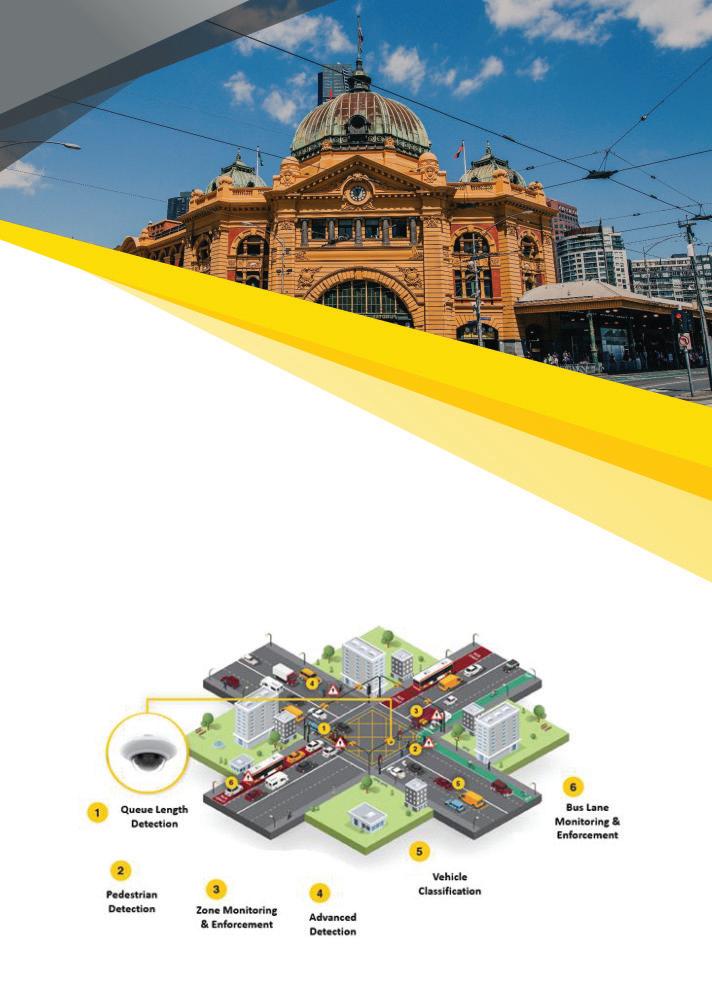
SmartGarbos – AI-Powered 5G Garbage Trucks for Roadside Asset Management
Category
Excellence in Research and Development Award
Submitting Organisation
Swinburne University of Technology
Collaborating Partners
Brimbank City Council
Optus
Amazon Web Services
Timely detection of roadside assets that require maintenance is crucial for improving citizen satisfaction. Currently, such maintenance issues are typically identified manually by residents or council workers, which is time consuming, expensive, and slow to respond. Swinburne University of Technology and Brimbank City Council, in collaboration with Optus and Amazon Web Services, have developed and deployed this solution funded by the Department of Industry, Science, Energy and Resources of Federal Government under the Australian 5G innovation Initiative Scheme.
First of its kind in Australia, this project delivered a solution that equipped waste collection trucks with Internet of Things (IoT) sensors (high resolution 3D depth sensing cameras, GPS, edge computers) and 5G technology to remotely capture roadside asset data in local government area (LGA). Using AI, the data is analysed in real-time to identify and report issues such as damaged road signs and illegal rubbish around LGAs. The solution has been deployed in 11 waste collection trucks in Brimbank and is operational since July 2022.
The project uncovers the following key features and findings.
• This solution leverages the existing waste collection trucks that operate every day within LGA (e.g., in Brimbank LGA waste collection trucks cover ~1,000 kms). A novel way of capturing transport related data within minimal cost.
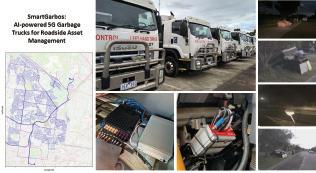
• First of its kind real-world deployment integrating IoT, 5G, artificial intelligence and edge and cloud computing.
• Novel AI models that produce on an average 85% accuracy in detecting issues with roadside asset.
This solution will significantly reduce the costs and time associated with maintaining roadside assets while improving citizen satisfaction and safety. Further, this solution offers a new scalable and cost-effective method for collecting data related to transport infrastructure in LGAs.
46 ITS AUSTRALIA AWARDS 2023 EXCELLENCE IN RESEARCH AND DEVELOPMENT AWARD
ITS Australia iMOVE Research Project –
Integrated Connected Data for Safer More Efficient Traffic Management Operations

Project Partners
ITS Australia
University of Melbourne
Transport for NSW
Department of Transport Victoria
Department of Transport and Main Roads
Queensland
The Commissioner of Main Roads Transport Accident Commission
This project’s aim is to identify and analyse specific aspects of existing and emergent connected and other vehicle and traffic data, to identify how these could supplement and improve existing network management approaches and be integrated with modern traffic control systems in the near-term.
The potential for these new and emerging sources to contribute to existing network control practices, particularly signalised intersections, present opportunities to improve traffic movement and reduce congestion.
Current traffic management systems are typically controlled based on relatively simplistic inputs, such as inductive loops. In recent years there has been significant growth in the sensors available to network operators as well as the data sources available, including the gradual emergence of connected vehicles and infrastructure.
The project aim is to identify and analyse current network management approaches, and where existing and emergent connected and other vehicle data and underlying infrastructure data can be integrated with modern traffic control systems in the near-term to improve operations. This project is highly consistent with longterm safety and mobility goals, while providing specific traffic system and driver behaviour improvements in the short term.
47
ITS Australia iMOVE Research Project –
Accessibility Guidelines for Low and Zero Emission Vehicle Charging Infrastructure
Project Partners
iMOVE Australia
Austroads
La Trobe University
ITS Australia
Charging a Low and Zero Emission Vehicle should be easy for all users, including people with disabilities and older people.

This project will develop guidelines for Low and Zero Emission Vehicle charging infrastructure by comparing best practices and collaborating with people with disability and industry.
Austroads has developed guidelines to cover the installation of charging infrastructure for Low and Zero Emission Vehicles (LZEVs), including requirements, location, usability, and design.
The guidelines are designed to aid road managers, and to prompt consideration of issues relating to planning and design. The document draws on work and guidance from across the member states and New Zealand, as well as international insights.
Austroads would like to understand what opportunities and challenges LZEV charging infrastructure represent for people with disability (PWD). Based on that understanding the current Austroads’ LZEV charging infrastructure guidelines can be updated or refined if required so that the guidelines also facilitate accessibility and inclusiveness.
48 ITS AUSTRALIA AWARDS 2023
Young Professionals 2023
Young professionals recognised by industry leaders for their contribution to the ITS industry.
Amirtha Chidambara Raj Engineer at Arcadis
Benjamin Kaufman
New Mobilities Specialist at Liftango
Edwin Lai
Graduate Transport Engineer at Jacobs
Lewis Hyman Software Developer at Mastercom (Australia), Orion Network
Liam Kennerson Systems Test Engineer at Cubic Transportation Systems
Nick Collins Acting Manager Transport Strategy at Department of Transport Victoria
Ryan Spence Systems Engineer at Cubic Transportation Systems
Sanchia Morris
Customer Program Manager - ITS at Directed Technologies
49
50 ITS AUSTRALIA AWARDS 2023 INDEX Acusensus Australia 39 Advanced Mobility Analytics Group 44 Agent Oriented Software 41 Amazon Web Services 46 Ambulance Victoria 27 Arcadis 48 Arup Australia 40 Australia Integrated Multimodal Ecosystem (AIMES) 27, 32 Australian Road Research Board 31 Austroads 30, 48 Bridj Technology 18 Brimbank City Council 46 Caterpillar 41 Centre for Robotics, Queensland University of Technology 41 Cisco 12, 31 City of Melbourne 34 Civil to Resources 16 Cohda Wireless 12 Cubic Transportation Systems 32, 48 Department for Infrastructure and Transport South Australia 26, 28 Department of Infrastructure, Planning and Logistics Northern Territory 26 Department of Infrastructure, Transport Regional Development, Communications and the Arts, Government of Australia 26 Department of State Growth Tasmania 26 Department of Transport and Main Roads Queensland 7, 20, 26, 41, 42, 47 Department of Transport Victoria 12, 22, 26, 32, 34, 42, 44, 48 Department of Transport Western Australia 26, 42 Directed Technologies 48 Drillman Global 16 EROAD 7 Federal Chamber of Automotive Industries 6, 7 Felicity Smart Infrastructure 13 Flinders University 28 Ford Motor Corporation 41 Fujitsu Australia 25 Google Maps 34 iMOVE Australia 7, 8, 20, 28, 32, 41, 42, 47, 48 Intelematics 19 ITS Australia 3, 6, 7, 47, 48 Jacobs 48 Kapsch TrafficCom Australia 44 Keolis Downer 28 La Trobe University 12, 48 Lexus Australia 27 Liftango 48 Masabi 25 Mastercom (Australia) 48 Metro Trains Melbourne 12 Moovit 22 National Heavy Vehicle Regulator 14 National Transport Commission 26 Navya 28 netBI 35 ODIN PASS 20, 21, 24 Optus 46 Orion Network 48 Perth South West Metropolitan Alliance 40 Public Transport Authority of Western Australia 35 Public Transport Victoria 34 PwC Australia 38 Q-Free Australia 7, 27 Rheinmetall Defence Australia 41 Royal Automobile Association of South Australia 28 Royal Automobile Club of Queensland 41 SAGE Group 15, 28 SenSen 14 Sensor Dynamics 43 SkedGo 20, 24 SkyBus 25 Swinburne University of Technology 46 Swiss Federal Institute of Technology 44 The University of Melbourne 12, 32, 44, 47 Transdev Australasia 36 Transmax 7, 37 Transport Canberra 26 Transport for NSW 7, 26, 31, 34, 38, 39, 42, 43, 47 Transport Management Consulting 7, 30 Transurban 7, 8 University of NSW 31 University of Queensland 20 University of Sydney 44 University of Technology Sydney 7, 42 Ventia - Brisbane Motorway Services 16 Ventura Bus Lines 22 Victoria Police 34 Yarra Trams 32
The ITS Australia Awards are a celebration of excellence in Australian Intelligent Transport Systems. its-australia.com.au






















































